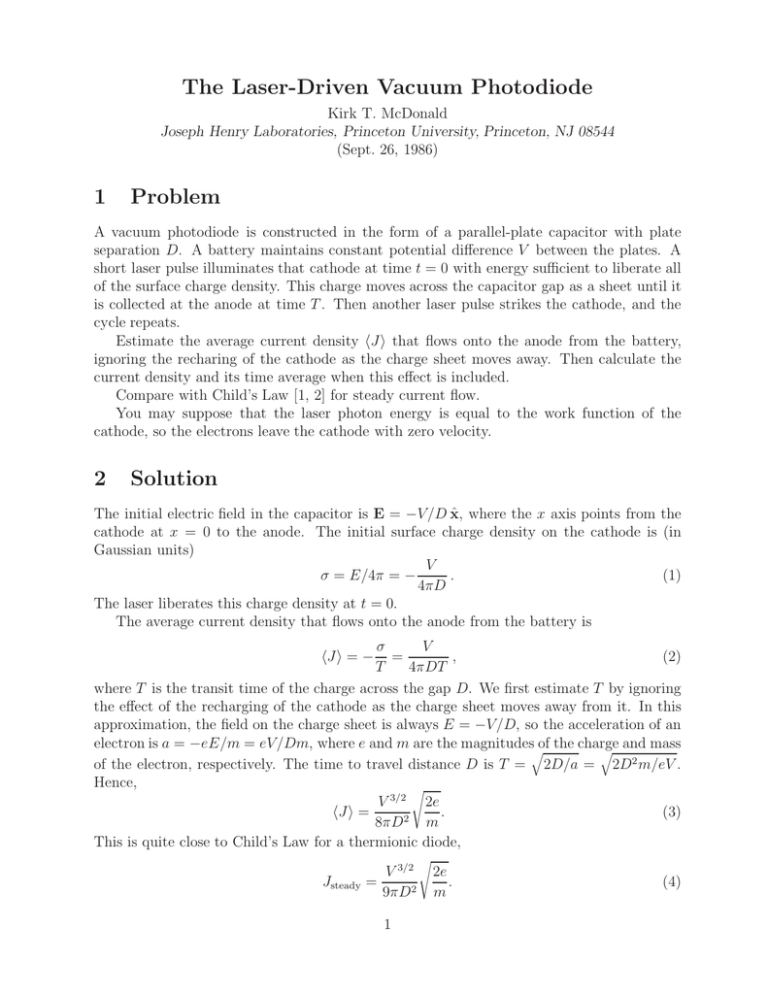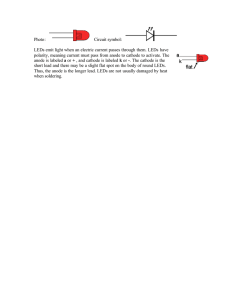as a PDF
advertisement

The Laser-Driven Vacuum Photodiode Kirk T. McDonald Joseph Henry Laboratories, Princeton University, Princeton, NJ 08544 (Sept. 26, 1986) 1 Problem A vacuum photodiode is constructed in the form of a parallel-plate capacitor with plate separation D. A battery maintains constant potential difference V between the plates. A short laser pulse illuminates that cathode at time t = 0 with energy sufficient to liberate all of the surface charge density. This charge moves across the capacitor gap as a sheet until it is collected at the anode at time T . Then another laser pulse strikes the cathode, and the cycle repeats. Estimate the average current density J that flows onto the anode from the battery, ignoring the recharing of the cathode as the charge sheet moves away. Then calculate the current density and its time average when this effect is included. Compare with Child’s Law [1, 2] for steady current flow. You may suppose that the laser photon energy is equal to the work function of the cathode, so the electrons leave the cathode with zero velocity. 2 Solution The initial electric field in the capacitor is E = −V/D x̂, where the x axis points from the cathode at x = 0 to the anode. The initial surface charge density on the cathode is (in Gaussian units) V . (1) σ = E/4π = − 4πD The laser liberates this charge density at t = 0. The average current density that flows onto the anode from the battery is V σ = , (2) T 4πDT where T is the transit time of the charge across the gap D. We first estimate T by ignoring the effect of the recharging of the cathode as the charge sheet moves away from it. In this approximation, the field on the charge sheet is always E = −V/D, so the acceleration of an electron is a = −eE/m = eV/Dm, where e and m are the magnitudesof the charge and mass of the electron, respectively. The time to travel distance D is T = 2D/a = 2D2 m/eV . Hence, V 3/2 2e . (3) J = 8πD2 m This is quite close to Child’s Law for a thermionic diode, J = − Jsteady V 3/2 = 9πD2 1 2e . m (4) We now make a detailed calculation, including the effect of the recharging of the cathode, which will reduce the average current density somewhat. At some time t, the charge sheet is at distance x(t) from the cathode, and the anode and cathode have charge densities σA and σ C , respectively. All the field lines that leave the anode terminate on either the charge sheet or on the cathode, so σ + σ C = −σA , (5) where σA and σ C are the charge densities on the anode and cathode, respectively. The the electric field strength in the region I between the anode and the charge sheet is EI = −4πσ A , (6) and that in region II between the charge sheet and the cathode is EII = 4πσ C . (7) The voltage between the capacitor plates is therefore, V = −EI (D − x) − EII x = 4πσ A D − V x , D (8) using eqs. (1) and (5)-(7), and taking the cathode to be at ground potential. Thus, σA = V x 1+ , 4πD D σC = − Vx , 4πD2 (9) and the current density flowing onto the anode is J (t) = σ̇A = V ẋ . 4πD2 (10) This differs from the average current density (2) in that ẋ/D = T , since ẋ varies with time. To find the velocity ẋ of the charge sheet, we consider the force on it, which is due to the field set up by charge densities on the anode and cathode, Eon σ = 2π(−σ A + σ C ) = − V 2x 1+ . 2d D (11) The equation of motion of an electron in the charge sheet is mẍ = −eEon σ eV 2x = 1+ , 2D D or (12) eV eV . (13) x= 2 mD 2mD With the initial condition that the electrons start from rest, x(0) = 0 = ẋ(0), we readily find that D x(t) = (cosh kt − 1), (14) 2 ẍ − 2 where k= eV . mD2 (15) The charge sheet reaches the anode at time T = 1 cosh−1 3. k (16) The average current density is, using (2) and (16), V V 3/2 J = = 4πDT 4π cosh−1 (3) D2 V 3/2 e = m 9.97 πD2 2e . m (17) The electron velocity follows from eq. (14), ẋ = Dk sinh kt, 2 (18) so the time dependence of the current density (10) is 1 V 3/2 J (t) = 8π D2 e sinh kt m (0 < t < T ). (19) A device that incorporates a laser-driven photocathode is the laser-triggered rf gun [3]. References [1] C.D. Child, Discharge from Hot CaO, Phys. Rev. 32, 492 (1911), http://puhep1.princeton.edu/~mcdonald/examples/EM/child_pr_32_492_11.pdf [2] I. Langmuir, The Effect of Space Charge and Residual Gases on Thermionic Currents in High Vacuum, Phys. Rev. 2, 450 (1913), http://puhep1.princeton.edu/~mcdonald/examples/EM/langmuir_pr_2_450_13.pdf [3] K.T. McDonald, Design of the Laser-Driven RF Electron Gun for the BNL Accelerator Test Facility, IEEE Trans. Electron Devices, 35, 2052-2059 (1988), http://puhep1.princeton.edu/~mcdonald/examples/accel/mcdonald_ieeeted_35_2052_88.pdf 3




